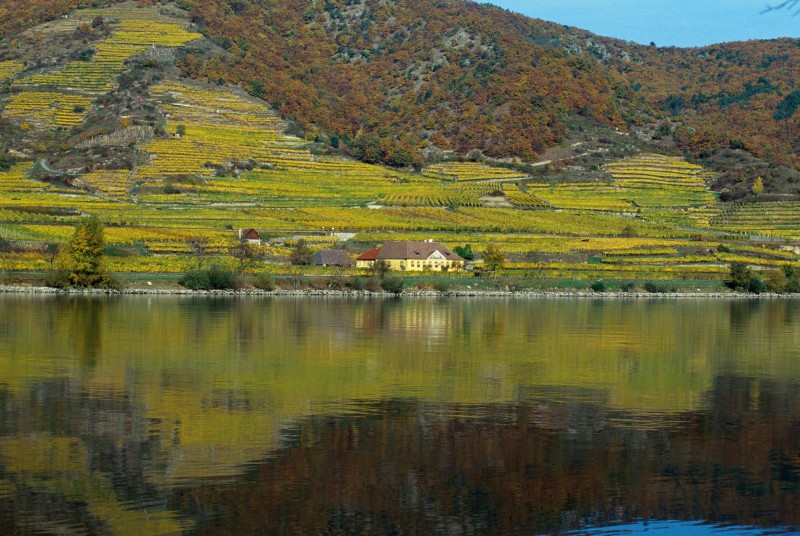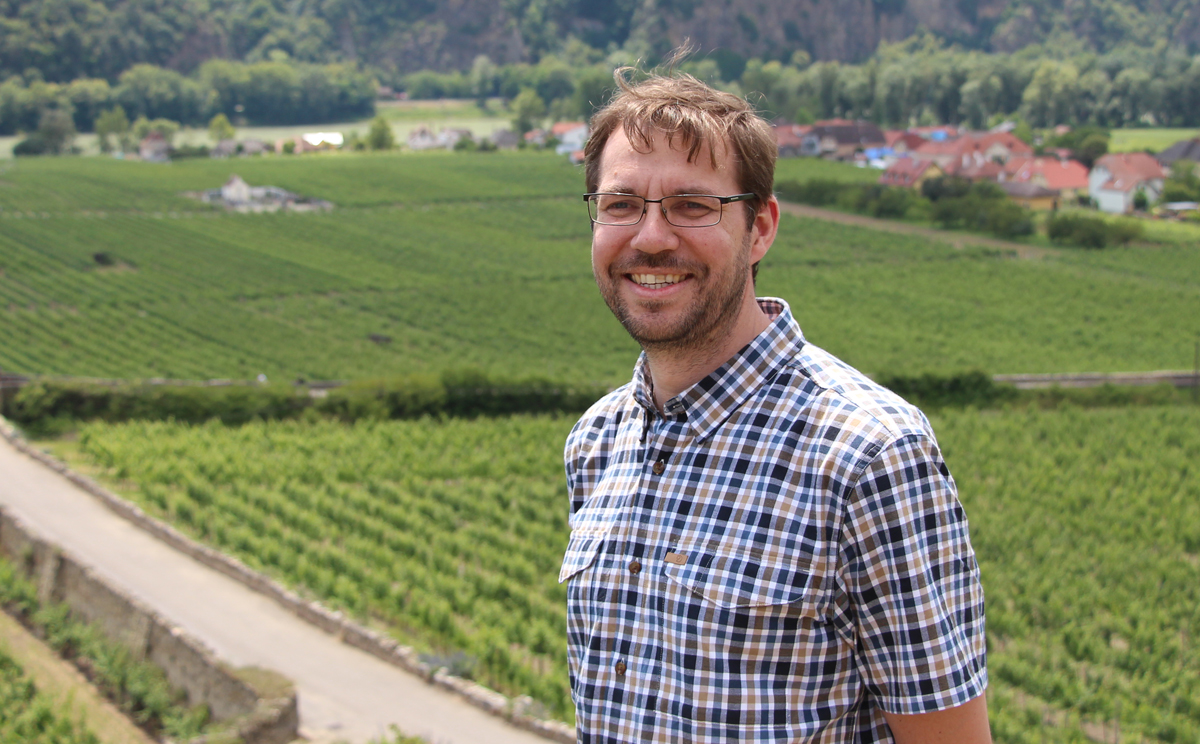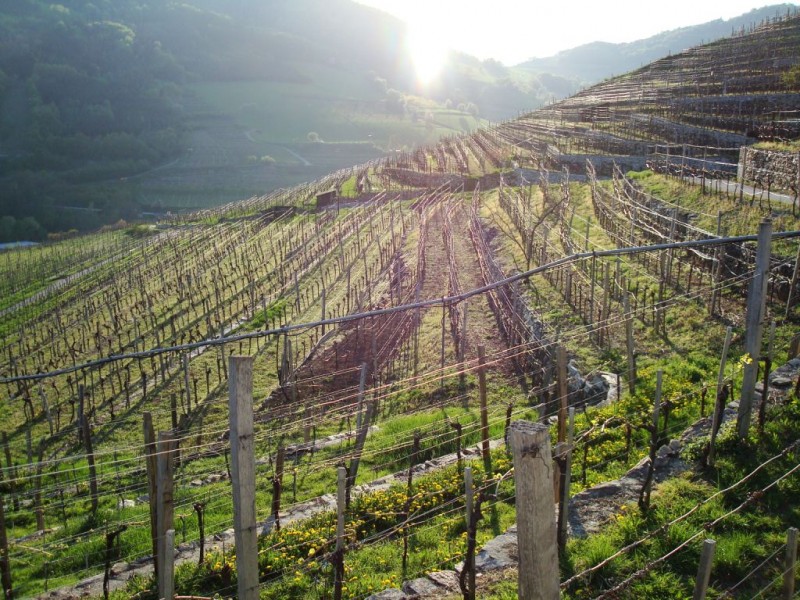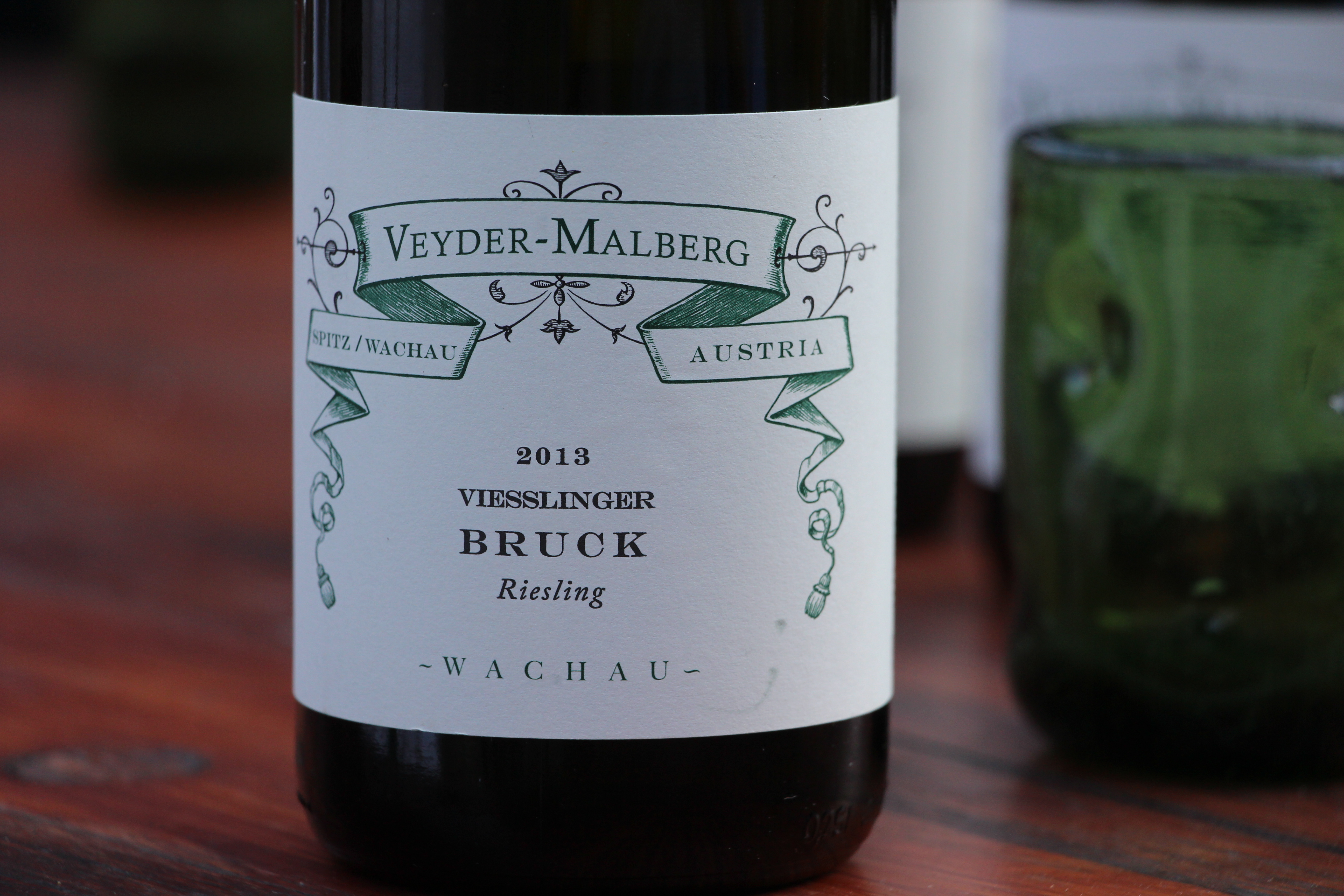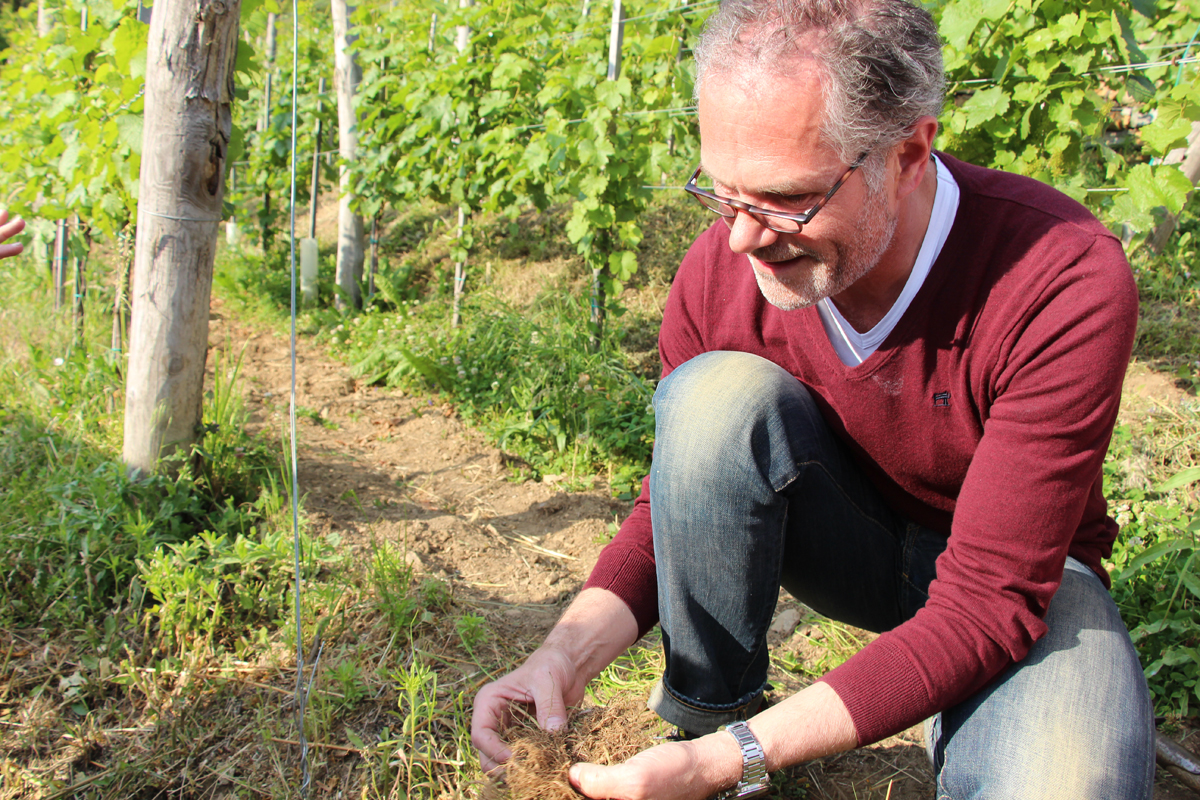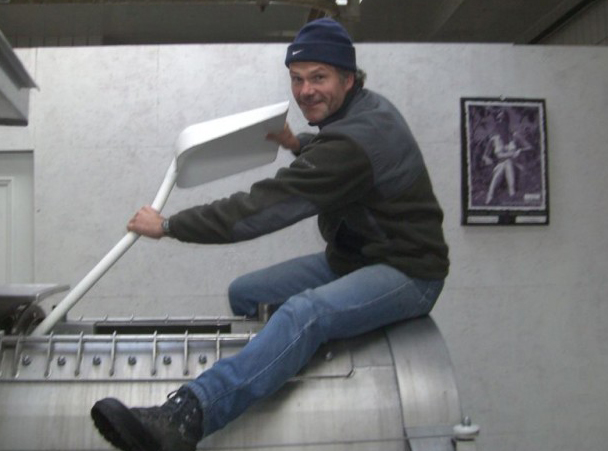I met Peter for the first time in a small and unassuming house, deep in the Austrian wine country. He lives in a quiet town, Spitz, tucked into the far western end of the country’s most famous wine region, the Wachau. The first time I heard about Peter was from my friend Sariya, who supplies me with great Austrian wines. She insisted that I meet this guy because she was sure that we would get along. She said that he was very interesting and that he and I are a lot alike. I wasn’t sure how to take that, but Sariya knows that I am a bit of a Peter Pan myself: feet rarely on the ground and head always in the clouds. It’s true, like Peter Pan, I would prefer to never grow up.
If you’ve never been to the Wachau, you need to add it to your bucket list. It’s gorgeous, and the culture is sophisticated, yet relaxed. Austria is one of my favorite culinary destinations; they make delicious dishes where you should avoid asking questions like: “What part of the animal does this come from?” Trust me, just eat it. The local restaurants, heurigers, serve regional specialties and can house legions of tourists. Here, you really have to keep your eyes on the road during summer because this area has a massive flow of older tourists who walk around like a bunch of stoned geese arguing about which way is South, as they stand in the middle of the road.
The Wachau looks like something out of a fairytale. It was forged by the Danube; over thousands of years, this river carved it’s way through the southernmost part of a hard ancient stone formation, called the Bohemian Massif. Here, the most important soil is called gneiss. It is commonly referred to as “primary rock” because it’s one of the oldest rock formations on the Earth’s surface as it originates more than 300 million years. When you hold one of these hard rocks in your hand, it’s hard to imagine that this river gorge even exists because the stone seems almost impenetrable despite how intense the Danube could’ve raged in its early years.
As far as the lay of the vineyard land and the style of wines are concerned, there are a couple of basics that are somewhat consistent. First, the low-lying and more flat areas, which are rich in soil nutrition with easier water access for the vines, are where you mostly find Gruner Veltliners and other white varieties, save Riesling. The Rieslings are usually planted on the steep hillsides, where the “primary rock” is the principal soil base. There are also some labeling terms –specific to the Wachau – that represent certain levels of ripeness. In order of ripeness, from the least to the most, the dry wines are classified as Steinfeder, Federspiel or Smaragd. In short, these terms were created by a group of likeminded and highly skilled winemakers who, in 1983, established strict regulations under a code called the Vinea Wachau, as “a dedication to natural wine production and strict control.” These guidelines deal with the origin of the wine, and impose regulations on things like additives, concentrators, “aromatizers”, and spinning cones. In short, this code is committed to the ideal “nature and nothing else”! So, what the heck do all these spinning cones and “aromatizers” mean anyways? I’ll tell you what it means… It means that most people think that the wine is only a natural process, and that drinking wine must be good for you. I’m sorry to be the bearer of bad news but today there is a lot less wine in a bottle, and a lot more other stuff. A good friend of mine, who is a doctor, sends me studies that contradict the “health craze” surrounding wine; indeed, scientific evidence shows that wine can be a contributing factor to cancer. The truth is that most wines are unethically made and are the likely culprits of these results. Those wines that are picked up at your local “natural market” for three or four bucks a bottle, that you place in your cart next to your “organic salmon” are the worst! Well, the Vinea Wachau ain’t havin’ it! Or, are they?… I guess it depends whom you ask.
Within the first five minutes of stepping into Peter’s world, I knew that Sariya was right. I hadn’t tasted the wines, but I could tell that I was in for a long and interesting ride. He invited me to his backyard to sit and chat about things. We didn’t go straight to the vineyards or to tasting, which I really appreciated. In all honesty, the main reason that I travel to visit vineyards and winemakers is to discuss what they discover about themselves in the process of crafting wine and how these discoveries are relevant to life. It’s the human element, not the technical aspect, that drives me. Most people I know in the wine business think that I’m a technical wine junkie, but that’s only the lesser half of it. I’m really in it to interact with great minds and to be exposed to the philosophy ingrained within people who make insightful, honest, and humbling wine. It’s far more interesting to explore the process, the thinking, and the convictions that drive their choices, not just the result of their choices.
As we sat on an old stone wall behind his house, Peter looked at me and asked with a sarcastic and ice-breaking grin: “So… what do you want to know?” as he threw his hands in the air and chuckled. It was clear that he was acknowledging the discomfort of first meeting someone and diving into the conversation with the usual array of a thousand technical questions (which I had) about his winemaking and vineyards. After all, what else would you ask a vigneron that you’ve just met? You’ve got to establish some kind of street cred, no? I smiled back at him and simply asked, “Why are you here?” He looked at me a little caught off-guard. I quickly rephrased, “I mean, why did you decide to come to the Wachau and not another place in Austria?” Peter smiled as he probably realized that I already knew a little bit about him. I knew that, two decades ago, after he finally grew up, he developed a career in graphic design and marketing. Eventually, he’d had enough of that and decided to pursue his desire to make wine, which he’s now been doing for almost twenty years. Peter turned away and looked at the ground to gather his thoughts. As he focused deeper on the ground, he slowly eked out: “I came here… because there is no doubt to me that the Wachau is the greatest terroir in Austria.” He paused, then he looked up at me, as though he was a doctor who was going to give me some rough news. “But…” Wait, let me back up a little bit…
I arrived to Austria a couple of days before my visit with Peter to visit a few friends and several new producers that I was going to start working with. I first visited the young Franz Hirtzberger. Franz and I had become friends about ten years ago when I took a six-month bicycling trip through Europe with a friend. We stayed in the Wachau for an entire week and Franz and another guy, Martin Wicker, took three days off just to hang out and drive us around. Anyway, I try to catch up with Franz every time I come. Shortly after I arrived, we started tasting through his 2010 range of wines, which were really impressive. I was surprised that Franz didn’t seem convinced of the quality of the wines he had put in bottle this vintage. He spoke about them as if they were a little light for his taste, which I thought was funny. I mean, here’s a guy who is really at the top of the food chain, who just nutted a perfectly focused and elegant vintage, and he is speaking about how much more “light” it is compared to other vintages. Light? Hirtzberger? That sounds like the perfect vintage for him… Anyway, as we were tasting, he asked who else I was visiting. I told him that we had just started working with Emmerich Knoll as well as Martin Mittelbach, from Tegernseerhof – both well-respected producers and friends of Franz. Although I hesitated, I eventually let him know that I would visit, on the next day, a new producer in the same town as Franz, named Peter Veyder-Malberg. The name set Franz back a little. I could tell that he had an opinion, but he cautiously asked me what I thought about the wines. I told him that I hadn’t tasted them yet, so I had no opinion. As our tasting ended, Franz walked me to the door and said, “Tell Peter hello for me.” Franz gave me a strange look, which is normal for Franz and then added: “I’d like to know what you think of the wines. It’ll be interesting to hear your opinion.” I asked what he meant by that, but he dodged the question with a big smile and repeated that he just wants to know what I think. As I got into my car and drove back to Krems, I thought: “That was strange… Maybe this guy Peter is doing some weird orange wine, or something… Who ever heard of orange wine in the Wachau anyway?”
The next day, I visited Emmerich Knoll and his next-door neighbor Martin Mittelbach. They were both great tastings, completely opposite styles on this end of the Wachau where it’s easy to find wines that are more sun-touched and a bit more generous than the vineyards of the Wachau as you move west, towards Spitz. The Knoll wines are top-notch and have a sort of baroque and refined intensity, while Martin’s wines have fierce angles and focused high-toned energy. It’s amazing how completely different these wines are even though they come from the same hills. I had a great tasting with Martin in the morning and then I saw Emmerich for another tasting and a quick bite. He already knew that I was going to visit Peter after lunch as they both work with me through Sariya. As we parted, Emmerich said, “Give me a call when you’re done, maybe we can have dinner together. Plus, I’m really interested to hear what you think of Peter’s wines…” Like with Franz, I asked why. “I’m just curious… They’re different, that’s all. But seriously, call me, I’d really like to hear your opinion.” He had that classic Emmerich smile, the one where you are not sure if he’s teasing you or being serious.
As I drove to Peter’s, I was laughing a little in my head thinking: “Ok, first Franz, and now Emmerich… Strange… what the heck is up with this guy, Peter?”
“… I hate the Wachau style of wine,” Peter finished. Whoa! Controversy! I love it! This honest and pointed comment immediately put a smile on my face. Peter went back and forth between gazing at the ground and looking back up at me as he calmly explained that it was hard for him to enjoy the style of wines made from this superior Austrian terroir. He couldn’t stand most of them because they were always big and powerful, even the so-called elegant producers. And that, no one, but a few “outcasts”, were pursuing more natural ways to grow fruit. He felt that the Vinea Wachau regulations force the hand of winemakers to make wine of a certain style, and that a lot of the wines are riddled with synthetic chemicals from the vineyards because they don’t regulate the vineyard practices; so long as you conform to their rules in the cellar, all is good. He kept going and I just sat there and listened as the top spun, if you know what I mean. The smile on my face must have been huge as I watched Peter pour his heart out with sincere conviction. Why don’t you tell me how you really feel Peter?! Man ‘o man! I loved this guy and what he was saying. He was singing to the choir and it was a big breath of fresh air. Believe me, I have almost cried at the obvious use of chemicals in the vineyards of the countless great estates I visited throughout Europe. There are many great wines made under these conditions and its hard not to wonder how much better they could be… Through his tirade, I kept thinking: “This guy’s wines are either going to really suck or be insanely good.”
After about ten minutes of putting it on the table, and believe me, it was all on the table, Peter looked at me with his big boyish smile.
He knew that he was controversial, but his critique was justified. He was an outsider, and no one on the inside was saying the same things that Peter found to be an obvious fault of the greatest region in all of Austria. “So…”, Peter said with a Shakespearean voice to clear the heavy air, “What shall we do now?” Time to see these “natural” vineyards! I was excited by this exchange, but I was a little worried about the tasting because I have a terrible poker face. If I don’t like them, he will know by look on my face.
The first time I was in the vineyard with Peter was the same as all the visits I’ve had with him since. The pure and joyous energy that radiates from this man when he is in his vineyards is truly incredible. He calls his vines his children, and that’s exactly how it feels. There was life everywhere: bugs, herbs, birds, grasses and Peter’s big smile. The pleasure and joy he manifests in the vineyards is how I want to feel everyday.
He took me to his primary Riesling vineyard, Bruck, located in the Spitzer Graben, which is the coldest section of the Wachau. The Spitzer Graben is fresh and beautiful. Standing in his vineyard and looking across the way to the other side of the valley is breathtaking. The air is so fresh and clear that it feels like you could reach your hand out and grab the little house you see miles away across the valley. There is a special feeling in this place –the vibe is different from the rest of the Wachau. He continued driving me around to show me new sites he wanted to buy and replant. I was impressed by the tasks that he was taking on; only with an occasional helper, he wants to rebuild terraced walls that hadn’t been tended to in decades, some for over a century. This is seriously hard work.
It’s amazing how many lost, or forgotten, vineyards there are all over the place. Some of them are right in front of your face, and you can’t help but wonder why there are not vines there anymore. There are many places that I’ve visited, like Lessona in Northern Piedmont, or the “Vins de Vienne”, just north of Cote Rotie in France, that have ancient abandoned vineyards. These places were forgotten after phylloxera devastated most of Europe in the late 1800’s; this terrible insect made way to a century of tough economic times and long, horrific wars. Can you imagine facing phylloxera, which destroyed entire crops for decades, then going through World War I, followed by World War II, and finally, dealing with mental and physical post-war recovery? I’m just a country bumpkin from Montana, so I can’t imagine it. After these times, busting my butt up a steep hill to make wines that couldn’t fetch a decent price would be the last thing I’d want to do. This is one of the obvious reasons why it’s still easy to drive in places like the Wachau, or the Mosel in Germany, and find gorgeous hills that have been completely abandoned. No one is touching them because the work on some of these steep hills is expensive and too damn hard. Believe me, they are all over the place and, if you have the will, they are available. I know a guy that has the will…
The moment of truth. We made our way back from the vineyards a bit early as spring had just started and nightfall was on its way. I sat down in Peter’s cold, quiet house while he went downstairs to grab a box of wine. He emerged with seven wines, which were already open. He pulled out a couple of big hand-crafted glasses, made by the up-and-coming Austrian glass producer, Zalto. Honestly, I don’t like to taste wines that have been open for a day or so on my first visit with a producer, but Peter was making such a small amount of wine that I didn’t ask to taste fresh samples. As he poured the first wine into my glass, I couldn’t help it, I had to ask him how long the wine was open. He looked to the ceiling, as though the answer was there, then at the bottles, still searching. He paused and started to calculate: “Let’s see, I just got back from skiing, and I had some journalists visiting from Norway, and that was a little over a week ago, so, maybe ten days, I think…” Great. I’ve come all this way to deal with a guy who’s going to serve me up a box full of wines that I’ll have to wade my way through, searching for reasons why Sariya said I had to meet this guy. He didn’t pour himself any, just me. Perfect, he won’t drink his own wines that have been open for 10 days, but why not pawn them off on me? –I don’t mind, really, I don’t. Maybe this is the kind of stuff that Franz and Emmerich were talking about… Ten days??
First wine. Not possible… You’ve got to be joking me… I stuck my nose all the way in this massive glass, looking for reasons to cut this wine to shreds. Not a chance. The aromas kept pulling me closer into a glass that revealed the smell and taste of these hills before man even existed. I looked at Peter in disbelief. He was oblivious to my initial reaction –probably because I was completely silent. I stayed with the glass for quite a while. I tasted and spat. I had to move on. I needed to taste more because this had to be a fluke, a lucky shot. Despite how much this wine intrigued me, it was too early to put any of my cards on the table. Second glass. Nope. Not luck: this wine was even more intoxicating than the first. It was nuts! I had to say something, but all I could manage to say was, “So, how long did you say these were open?” “I don’t remember exactly, but I’m sure it was at the beginning of last week, so something like ten days, or maybe twelve.” “Really?” “Yeah, something like that, but I’m not exactly sure.” The kicker? It was Gruner Veltliner, not Riesling. I was tripping. I mean, great Gruner is pretty good juice, but for me it’s got nothing on great Riesling. These first two wines, however, were unbelievable. I kid you not, I was fixated on the second Gruner, Viessling, for over forty-five minutes, and it had been open for more than TEN DAYS!
As I tasted the next wines, two other Gruners, from different vintages, my mind went nuts. I started spitting out descriptors that I’d never even used before; they were flowing from my mouth like the Danube gone wild. Eventually, Peter said, “Wow, you taste all that in my wines?” “Yeah, man. I’ve never tasted wines like these before.” He grabbed a glass and started tasting with me. I was on fire and these wines brought me to a level of focus that doesn’t happen too often. Peter started to laugh and told me that he’s never even looked at his own wines the way I was painting them. He started tripping too. We were like Cheech and Chong, “Hey man, do you smell that, man?” “No man, smell what, man?” “Really, man? You know that smell, man.” “Oh yeah, man, I can smell that now, man.”
Then he brought out the guns –the Rieslings. If tasting these wines were the last thing I’d ever done in my life, I would have been cool with that –I really would have. I was single at the time so I had no one waiting for me. Even if I walked out of Peter’s door after drinking these wines and forgot to look both ways and got slammed across the Danube by an oncoming semi? Nope, I wouldn’t feel slighted in this life… Plus, these Rieslings were beyond my capacity to fully enjoy, let alone comprehend. In fact, they were so damn good that I didn’t even want to drink them. I know, that’s a ridiculous thing to say, but it’s true… I just wanted to lock in the smell and float down the river on my back and contemplate the meaning of life. They were, crazy-good. I’m sitting here trying to find a way to properly describe them, but I can’t –describing sublime perfection is not possible. When I managed to finally put a sip in my mouth, that’s when I started flying through the Spitzer Graben with Peter Pan. Peter had brought me to his Neverland, back to moments of bliss I felt when I first discovered wine. Back then, I didn’t have a care in the world, and here with Peter, the feeling was the same. He was serving me taste after taste from the fountain of youth –I was going to live forever! On occasion, I’d slip out of this nirvana to come back into my flawed mind to debate if this was even possible. I mean can a wine, any wine, do this to someone, especially after being open for ten days? Have I gone mad? What was even more astounding was that 2008 was his first vintage in the Wachau, and that’s what we were mostly tasting. It was just insane –he was a rookie…
Suddenly, it was 8:30. I forgot to call Emmerich! I told Peter earlier that I had to go meet up with him, but we both forgot. By the time we realized what time it was, we had spent over four hours, tasting seven wines! I know that may be hard to believe, in a moment which I lost track of both time and reality, but it really did take that long to simply attempt to grasp the depth of these wines. Peter looked at his watch and said that it was probably best to call Emmerich and cancel because it was so late. Cancel on Emmerich Knoll? I can’t. That’s crazy, Emmerich is a good friend (and a legend himself) and I always cherish my time with him. Wait, I can’t leave this moment behind either… Am I crazy?! “Ok, can you call Emmerich for me?” I was looking forward to getting back to Emmerich, but I was so thrilled to stay and dig in a little bit more with this guy. He was special and I really wanted to stay. So, I did. We ended up going down the street to the local restaurant to sort out another bottle of Riesling, which was thrilling for me to drink a freshly opened bottle. This newly opened bottle was a perfect wine. It made me realize that the wines that were open for ten days hadn’t even begun to show any signs of fatigue from the moment they were open.
Over dinner, we continued the discussion we started when I first arrived. We went a little deeper and I got a great insight into the mind of someone whom, when it comes to wine philosophy and practice, I have come to consider a genius. I realized that Peter truly loved the Wachau, and that’s why he had strong opinions. Also, I felt like, deep down, he wanted to be a part of this local group, but he simply couldn’t relate to their philosophy. I now understood why Franz and Emmerich were curious about what I thought. It wasn’t only about the taste of his wines, it was probably about Peter’s perspective on things. The fathers of Franz and Emmerich were two of the main players that set-up the guidelines of the Vinea Wachau, which imposed strict regulations to keep quality standards of the wines from the Wachau at the highest level in Austria. And believe me, it worked. The Wachau is the undisputed king of Austrian wine regions, and it’s largely due to the Vinea Wachau. If one wants to use the terms, Steinfeder (which we never see in the States), Federspiel and Smaragd, you must follow the rules. What’s more, these juggernauts in the Austrian wine trade, were crucial in stopping the construction of a dam on the Danube that would have affected their great terroir and every other region close to it. These guys are living legends, and despite their request to Peter that he join the Vinea Wachau and “go with the flow”, Peter wouldn’t bend. He couldn’t bend.
So, what’s with all of these rules from the Vinea Wachau that Peter couldn’t accept? One example is the regulation of must-weights, which refers to the amount of sugar in the grapes at the time of harvest and, to a lesser extent, the maximum amount of sugar left in the finished wines. For example, the amount of sugar in the grapes to achieve the level of Smaragd ripeness must be at a minimum of 12.5% alcohol (with no maximum and not a tenth of a point less) and the remaining sugar in the wine must not exceed nine grams per liter. In a cold area like Spitz, in order to achieve this requirement with natural alcohol, the vigneron may have to wait until the grapes are either somewhat dehydrated, or carry a little bit of botrytis (the noble rot). The result is the concentration of sugar in the berry in order to meet the minimum amount required for a Smaragd wine. One of my friends, who worked in the Wachau for three seasons, explained that, often times, there is no canopy left on the vines while they are starting to harvest their Smaragd grapes. They may let it get to this point in order to reach the minimum alcohol requirement. That’s extreme viticulture and a severe restriction for a place that has a different set of circumstances that the warmer parts of the Wachau.
There are many other challenges for Peter regarding the Vinea Wachau; Sariya, however, distilled it down to one necessity for Peter – flexibility. She also added, “Peter has a healthy disrespect for authority, so the rules in and of themselves are a problem for him.” That is exactly it. In order to remain flexible, Peter refused to bend to the Vinea Wachau. Why would he? Flexibility is crucial for a creative mind, especially for one that is constantly thinking outside of the box. How can he ignore the fact that disregarding the Vinea Wachau rules allows him to produce better wine? After visiting the Wachau for many years, I realized that, like many of the great wine regions in the world, they seem to have a myopic view on wine and viticulture. Like many other famous wine regions, the Wachau’s “if the wheel ain’t broke, don’t fix it” is not a progressive mentality. Aside from the many little disagreements Peter has with them, this is likely another reason why Peter chose not to join the Vinea Wachau.
I truly love the Wachau, but when Peter presented me with his predicament, I realized that the Vinea Wachau is fairly selective regarding their “nature and nothing more” mantra. According to Peter, their rules solely concern the augmentation of the wines in the cellar; they do not address treatments and rules to better conserve the nature that exists in their vineyards. It is possible that, back when the Vinea Wachau was created, they didn’t realize that the long-term implications of the unnatural vineyard treatments may undermine some of the life in their wines. Today, it is impossible to walk in the vineyards of the Wachau and ignore what is obvious –the majority of soils are far from healthy. Sadly, this is the case with almost every “great” wine region in the world. I know what you’re thinking… But, no, the Vinea Wachau is not Captain Hook in this story… The Vinea Wachau is the strongest captain in Austria, and deserves respect as it is served under honorable ethics. It must be said, however, that the boat looks clean from the outside; but once you get into the bilge, there’s a bit of work to be done.
After our conversation, I realized that Peter’s plight makes sense: both the fastidious restrictions on the cellar work and the surprising absence of regulation on the vineyards affect the natural character of the grapes. If Peter’s wines conformed, they wouldn’t carry the thrust and energy that his wines needed to makes us fly. They would be too overweight and all grown up, past their youthful energy –boring adults. Peter couldn’t clip his own wings for their ideals –his wings are both his freedom and his ideals. If he did, he would no longer be the Peter that he wanted to be, and he wouldn’t make wines that bring out my inner-child and make me feel like I’m going to live forever while drinking these wines from Neverland.
In the end, it was Peter’s Rieslings that brought me to this highest point of this enlightening experience and not the Gruners, which were amazing nonetheless. I do enjoy drinking Gruner on occasion, but it’s not a wine that excites me to the level of the greatest expressions of Chenin Blanc, Chardonnay or Riesling –my holy trio of white wines. The Rieslings that Peter makes are wines I would put at the highest level of all the white wines I drink, from anywhere in the world. There are many other producers of dry Riesling that get me going, Germany’s Emerich Schonleber in the Nahe, or Klaus Peter Keller from the Rheinhessen are two of them. However, if you were to ask me who makes my favorite dry Riesling, my answer would be swift and unflinching: Peter Veyder Malberg.
Conceptually, Peter is completely in tune with my frequency. I have visited well over 500 different estates in Europe, and in each of them, with the exception of maybe 30, I have spent a good amount of time talking about wine, geology, terroir and the nature of things specific to their vineyards and cellar practices. I’ve met only a select few vignerons who possess this type of rarified talent and determination that Peter has. Amongst these elite, there are even fewer that do almost all the of the handwork themselves in their own vineyards, like Peter does. Believe me, there is a difference in the work when the vigneron does it with his own hands. Aside from the philosophy and emotion that drives Peter, he is a true technician in the cellar as well. The mastery of his craft, combined with this great terroir, pave the way for the brilliant and subtle artistic expression of his wines.
Despite my perspective, I don’t think that Peter looks at himself as an artist. He gives me the impression that he is a man who understands that he’s just here for a moment in time. He is humbly following his passion. His unwavering conviction keeps him putting up rock after rock, back onto his ancient terraced vineyards. He is clearly on his path, and no one else’s. On a recent visit, I asked Peter about his love life. He responded, “I don’t have time for that. My vines need me.” Peter’s vines are his Lost Boys, he feels at home with them. Even if his Wendy did someday show up, she may have a hard time finding Peter Veyder-Malberg, but she wouldn’t have any trouble finding Peter Pan.
I’m excited to see what the future brings to Peter and what impact he, quietly, might have on the Wachau. For me, his wines already dance with perfection, so I can’t imagine how much better they could be. In the scope of the great wines of the world, it will be impossible for those in the Wachau to ignore the results of Peter’s work. Yes, they taste different from other Wachau wines, but that is the point. There is magic and an energy that are singular to his wines. It’s clear that the codex of the Vinea Wachau seeks to preserve nature in the cellar, but somehow, most that follow its rules seem to be neglecting the nature that once existed in their vineyards. I have walked many vineyards, and believe me, there is room for improvement, even in the vineyards of some of the greatest producers in the Wachau. I may not have degrees to make such claims to the scientific community, but as Dylan pointed out, “You don’t need a weatherman to know which way the wind blows.” I hope that more producers, who are already making great wines in the Wachau, will eventually start poking around Neverland to see what Peter is up to. There is already one, and his wines are a remarkable departure from what was made just a couple of years before.
My business partner, and long-time friend, Donny, went to visit Peter two weeks after I was there. We could’ve probably gone together, but the timing wasn’t right for us. I went off to Germany after my visits in Austria, and then to France. Before Donny got to Austria, I sent him an email about my experience with Peter and told him that his wines blew my mind. I hoped that we would share the same impression of Peter, and his wines. We met up in Los Angeles after we both got back to California. Of course, I wanted to know how everything was and what he was excited about. He began to tell me an all too familiar story about his time with Peter and related to my experience of the energy of his vineyards. He also told me that Peter went downstairs to get a box of wine that had a bunch of open bottles in it. He also was completely blown away by what Peter poured for him, and like me, he was curious about how long the wines had been open. “Hmm… Let me see.” I can imagine Peter inspecting the bottles like he had done with me two weeks earlier. “Ahh, I know…, almost a month ago… In fact, these are the exact same bottles that Ted tasted.”

